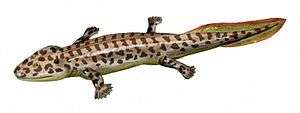Mandageria
| Mandageria Temporal range: Late Devonian | |
|---|---|
| Scientific classification | |
| Kingdom: | Animalia |
| Phylum: | Chordata |
| Subphylum: | Vertebrata |
| Class: | Osteichthyes |
| Subclass: | Sarcopterygii |
| Superorder: | Crossopterygii |
| Order: | Osteolepiforms |
| Family: | Tristichopteridae |
| Genus: | Mandageria |
| Species: | M. fairfaxi |
| Binomial name | |
| Mandageria fairfaxi Johanson & Ahlberg, 1997 | |
Mandageria (Pronunciation: Man-daj-ee-ree-a fair-fax-i) is an extinct genus of lobe-finned fish.[1] Mandageria lived in the Late Devonian period (Frasnian – Famennian). It is in related group with Hyneria, however, Mandageria was smaller, but probably it hunted in the same way.
Mandageria has been named after the philanthropist James Fairfax, and the Mandagery Sandstone formation near Canowindra, Australia in which the fossils were found. Mandageria fairfaxi is the state fossil emblem for New South Wales.[2]
Description
Mandageria was a large predator about 1.5 to 2 m (4.9 to 6.6 ft) long. It had a long torpedo-shaped body and large tail fins. Mandageria also had large pectoral fins which had helped it manoeuvre around submerged logs when preparing to attack its prey.[1] Mandageria had a functional neck joint, an otherwise uncommon feature among fish - Tiktaalik, Tarrasius, placoderms (esp. Arthrodira) and seahorses being other exceptions.[3]
References
- 1 2 Age of Fishes Museum, Canowindra
- ↑ "NSW State Flag & Emblems". NSW Government. Archived from the original on 18 September 2015. Retrieved 5 October 2015.
- ↑ Johanson, Z., Ahlberg, P. and Ritchie, A. (March 2003). "The braincase and palate of the tetrapodomorph sarcopterygian mandageria fairfaxi: morphological variability near the fish–tetrapod transition". Palaeontology. 46 (2): 271–293. doi:10.1111/1475-4983.00298.
External links
- Mandageria at Palaeos
- Review of Mandageria
- The braincase and palate of Mandageria fairfaxi
- The fossil skull of Mandageria
- Reconstruction of Mandageria
- Mandageria page and size comparison to a person and other lobe-finned fish

